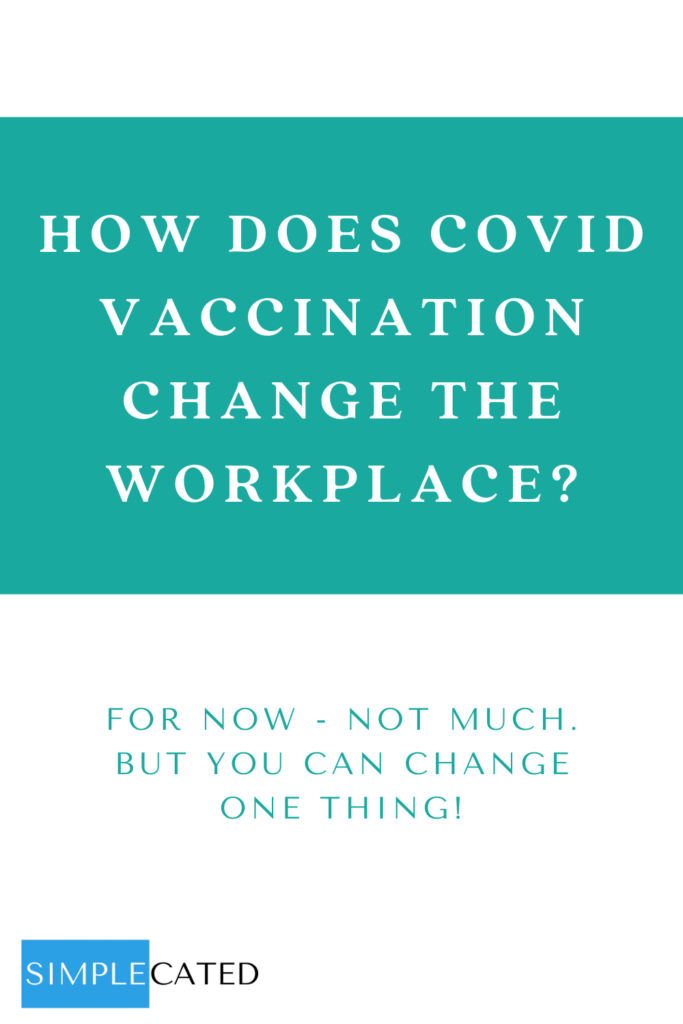In the words of Hamilton, “I am not throwin’ away my shot!” As more and more people get vaccinated each day, hope rises higher and higher. There’s a light at the end of the tunnel! As the eligibility for vaccines widens, more and more of your employees are hopefully getting their vaccines. So, you’re probably wondering, how does COVID vaccination change the workplace?
(First, remember the importance of encouraging your employees to get vaccinated! Be proactive with your communication plan. Survey your employees to find out (1) whether they plan to get vaccinated and (2) the reasons for those who don’t plan to get vaccinated. This will be a huge help to you in designing an effective communication plan. One piece of advice I keep hearing is to communicate facts from medical professionals. Check out this post for more tips.)
Back to our question. The short answer is – not much will change at this point. In fact, the only change for right now is that fully vaccinated employees won’t have to quarantine if exposed to COVID (unless they develop symptoms).
Here are the CDC guidelines for what vaccinated people can do:
Fully vaccinated people can:
Visit with other fully vaccinated people indoors without wearing masks or physical distancing
Visit with unvaccinated people from a single household who are at low risk for severe COVID-19 disease indoors without wearing masks or physical distancing
Refrain from quarantine and testing following a known exposure if asymptomatic
After this, the CDC provides a whole list of things that vaccinated people should continue to do including:
Take precautions in public like wearing a well-fitted mask and physical distancing
Wear masks, practice physical distancing, and adhere to other prevention measures when visiting with unvaccinated people who are at increased risk for severe COVID-19 disease or who have an unvaccinated household member who is at increased risk for severe COVID-19 disease
Avoid medium- and large-sized in-person gatherings
Get tested if experiencing COVID-19 symptoms
According to the CDC, vaccinated people should really focus on the risks to unvaccinated people. “Therefore, the level of precautions taken should be determined by the characteristics of the unvaccinated people, who remain unprotected against COVID-19.“
When it comes to your workplace, the only change for now is that employees who are fully vaccinated don’t have to quarantine if exposed to COVID. Keep in mind the CDC’s definition of “fully vaccinated” is at least 2 weeks since the second dose (or since the single-dose vaccine such as with Johnson & Johnson).
Otherwise, all other protocols remain the same. Even if you have a small number of employees, it’s likely not everyone has been vaccinated yet. Even if they are, keep in mind item #2 from the continuation list above. Vaccinated employees might have an unvaccinated household member at increased risk. The safest thing to do is to keep all protocols in place. (This also means all safety protocols for customers and visitors remain in place.)
Even though there’s only one change for now, it’s a change that can be really helpful for your organization! Many employers have struggled to continue operating as exposed employees needed to quarantine. Now that fully vaccinated employees don’t have to quarantine, you’ll have fewer staffing issues on your hands! (Just make sure they do start quarantining if they experience symptoms.)
I’m hearing more and more about leaders who are no longer wearing masks or social distancing at work. This is very dangerous. No leader or employee should create unsafe working conditions (or unsafe conditions for customers or visitors). As much as we all are so tired of COVID, it’s still here. The light is at the end of the tunnel, but we’re not there yet. So, let’s stay diligent and responsible so that we get to that light as soon as possible!
Photo credit: By The Xavier Lorenzo Collection





